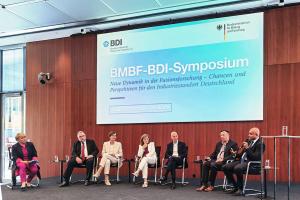Fusion on the agenda in Berlin

"In view of the challenges ahead we have to be open to all technologies," the Federal Minister for Research Bettina Stark-Watzinger said. "Fusion has to be part of the agenda." Together with Siegfried Russwurm, BDI President, Sibylle Guenter, the Director of the Max Planck Institute for Plasma Physics (IPP), Frank Laukien, the executive chairman of the newly formed private startup Gauss Fusion, and leading representatives from Siemens Energy and the provider for industrial laser technology Trumpf SE, the Minister spoke about the state of fusion research in Germany and the options to move forward—whether with publicly funded projects or through a growing number of private initiatives. As fusion startups thrive in the United States, the United Kingdom, and elsewhere, "Europe risks falling behind," Laukien said. "We have to jump onto the train now."
Gauss Fusion was also part of an industry-focused fusion forum taking place that same morning. Around one hundred representatives of industry had responded to the invitation from Germany's Fusion Industrial Liaison Office to participate. They heard IPP physicist Hartmut Zohm sketch out the fusion landscape, and ITER engineer Jens Reich summarize the status and lessons learned of the ITER Project. "We cannot do without science," was the consensus of the morning. "But in the end industry will have to build it." Two private projects received special applause for their presentations: Proxima Fusion, a spin-out of the Wendelstein 7-X experiment, and the US-German laser-based initiative Focused Energy.
Late May, an expert commission appointed by the Federal Ministry had handed over a 150-page Memorandum on Laser Fusion after the experimental success of Lawrence Livermore. In a few more days, on 22 June, the Ministry is expected to publish an official strategy paper on the development of fusion energy. Stark-Watzinger seems to be committed: "Fusion has the potential to revolutionize our energy supply."
